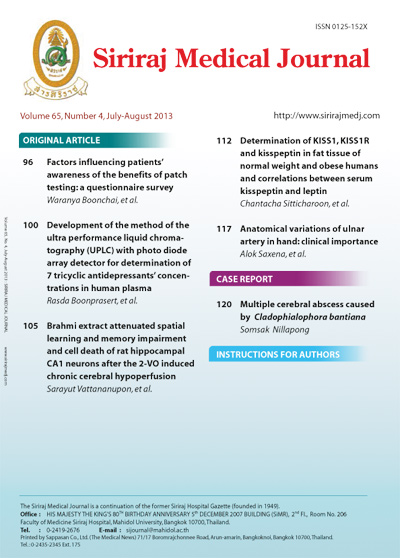Development of the Method of the Ultra Perfor- mance Liquid Chromatography (UPLC) with Photo Diode Array Detector for Determination of 7 Tricyclic Antidepressants’ Concentrations in Human Plasma
Keywords:
UPLC/PDA, tricyclic antidepressant, therapeutic drug monitoringAbstract
Objective: Depression is one of the most common human illnesses. Tricyclic antidepressants (TCA) are widely used for the Anti-depressive medication including Amitriptyline, Imipramine, Desipramine, Nortriptyline, Doxepin, Trimipramine and Clomipramine. The adverse effects have become major medical problems with severe morbidity and mortality from their cardiovascular and neurological toxicity. Several studies have reported the relationship between their toxic effects and elevated plasma concentration of TCAs. Therefore, therapeutic drug monitoring (TDM) of these drugs might be useful. This study aimed to develop and validate the method of ultra performance liquid chromatography with photodiode array (UPLC/PDA) for determination of 7 TCAs’ concentrations in human plasma.
Methods: Chromatographic separation was carried out by the ACQUITY UPLCTM BEH Shield RP, 1.7 μm (100 x 2.1 mm.I.D.) and used Acetronitrile/Phosphate Buffer Solution (pH 8) with gradient program as a mobile phase. The ACQUITY UPLC® Photodiode Array (PDA) Detector was performed at wavelengths between 200-380 nm and quantification was done at 215 nm. The Solid Phase Extraction (SPE), was used for extraction. The method was developed and fully validated according to USFDA guideline.
Results: This method has an excellent separation result for 7 TCAs’ concentrations in 5 minutes. The limit of quantification (LOQ) was 20 ng/mL for all TCAs. This method was fully validated in terms of selectivity, accuracy, precision, linearity (r 2 >0.9975) and stability. The recoveries of extraction ranged from 56.11-76.37% with repeatability.
Conclusion: A rapid, sensitive, accurate and reproducible UPLC/PDA method for quantification of TCAs level in human plasma were developed and validated, suggesting that the developed methods are useful for the future routine analysis.
Downloads
Published
How to Cite
Issue
Section
License
Authors who publish with this journal agree to the following conditions:
Copyright Transfer
In submitting a manuscript, the authors acknowledge that the work will become the copyrighted property of Siriraj Medical Journal upon publication.
License
Articles are licensed under a Creative Commons Attribution-NonCommercial-NoDerivatives 4.0 International License (CC BY-NC-ND 4.0). This license allows for the sharing of the work for non-commercial purposes with proper attribution to the authors and the journal. However, it does not permit modifications or the creation of derivative works.
Sharing and Access
Authors are encouraged to share their article on their personal or institutional websites and through other non-commercial platforms. Doing so can increase readership and citations.











